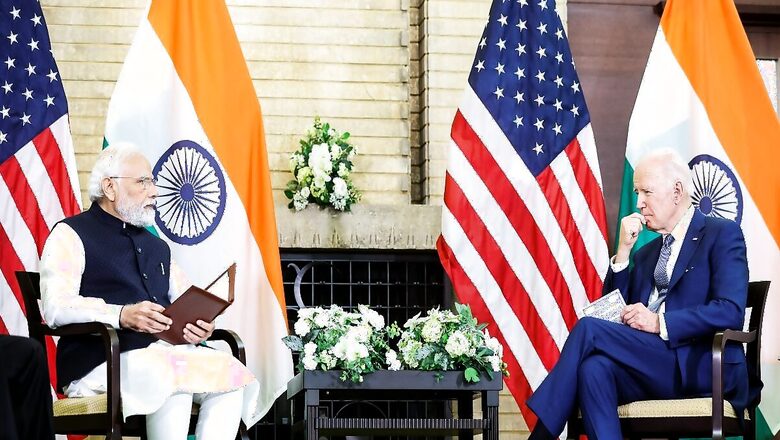
views
PM Modi’s Visit to the US
After the lows of the relationship following India’s Pokhran nuclear explosion in 1998, India and US ties have been on a steady upward path following the 13 rounds of talks between Jaswant Singh and Strobe Talbot from July 1998 to September 2000. Thereafter, one of the major agreements which worked out was the Civil Nuclear Deal or 123 Agreement in October 2008.
Prime Minister Narendra Modi has visited the US multiple times for bilateral and multi-lateral meetings since 2014. But his forthcoming visit from June 22 assumes significance because none of his visits earlier to the US were classified as a ‘state visit’. The previous two state visits included the one for President S Radhakrishnan in June 1963 and Prime Minister Manmohan Singh in November 2009. It is evident that a great amount of attention to detail is being given to the visit as the relationship between the two countries is of great strategic consequence.
Run Up To The Visit
In the run-up to the visit, the US Secretary of Defence, Lloyd Austin, came to India on June 4 and 5 with the aim of reinforcing a major defence partnership and advancing cooperation in critical domains.
Austin met Defence Minister Rajnath Singh and National Security Advisor Ajit Doval. India and the US also concluded a roadmap for defence industry cooperation, a landmark move expected to bolster India’s defence manufacturing. The roadmap is considered significant as Washington maintains strict controls over what domestic military technology can be shared or sold to other countries.
Following the footsteps of Austin, NSA Jake Sullivan, accompanied by Coordinator for Indo-Pacific Affairs in the National Security Council Kurt Campbell, visited India on June 13 and 14. Amongst his engagements was the second round of Initiative on Critical and Emerging Technologies (iCET) talks. Doval highlighted that one of the strong pillars of iCET was the joint collaboration between the US and India on defence trade and technology.
The recent launch of the India-US Strategic Trade Dialogue (IUSSTD), which was attended by Foreign Secretary Vinay Kwatra in the US on June 6, was one of the first outcomes of iCET. During the IUSSTD meeting, discussions were centred on identifying ways in which both governments could facilitate the development and trade of critical technologies in domains such as semiconductors, space, telecom, quantum, AI, defence, and biotech, among others. Both sides engaged in comprehensive reviews of relevant bilateral export control regulations, with the primary objective of constructing resilient and diversified supply chains for these strategic technologies.
According to Jake Sullivan, the iCET agenda is expanding and there’s “genuine commitment” between both sides to keep the initiative going. He said, “As we look ahead to the state visit Prime Minister Modi will be embarking upon in Washington next week…a number of the deliverables at the visit are not just bullet points on a page.” “They are fundamentally designed to remove those obstacles in defence trade, in high-tech trade, in investment in each of our countries, in taking away obstacles that have stood in the way of our scientists and researchers.” In his remarks, Doval said the iCET will give an ‘orbital jump’ to the strategic relations between India and the United States.
Jake Sullivan also met PM Modi during his visit.
Defence Cooperation
Amongst the main pillars of cooperation and convergence of interest between the two countries is Defence Cooperation, which began following the visit of US Air Force General Kickleighter to India in 1991, in which he proposed extensive training and exchanges between the two militaries, following which PM Narasimha Rao remarked that; “professional to professional relations were achieved more than politicians had been able to achieve in decades.”
Within the pillars of Defence Cooperation, it is aerospace which has been the biggest beneficiary due to its significant cooperation. Apart from the purchases of helicopters and transport aircraft to include C- 130 J planes, C-17 Transporters, P-81 Boeing Poseidon Maritime Reconnaissance aircraft, Boeing Apache Longbow AH-64E attack helicopters, Boeing CH-47 D/F Chinook heavy-lift helicopters, Harpoon Anti-Ship missiles and MH-80 Seahawk Maritime helicopters, it is now drones and the aircraft engine which are driving the partnership forward.
The two countries have apparently cleared the path for co-producing the GE-F414 fighter aircraft engine in India. It will power the LCA ‘Tejas’ Mk II and other future fighters. The formal signing is expected during Indian PM Modi’s US visit. It is expected to involve 100 percent transfer of technology (ToT) and manufacturing of this engine in India through a JV with HAL.
The 100 percent transfer of technology for the manufacturing of General Electric’s F-414 engine will be an unprecedented step. The 4.5-generation medium-weight-class fighter aircraft is expected to replace the MiG-21 aircraft. As per The Economist, “the Americans see it as their most generous proposal since the 2005, Civil Nuclear Cooperation Initiative.”
Aircraft Engines
Defence Research and Development Organisation’s (DRDO) Gas Turbine Research Establishment (GTRE) had been trying to make the ‘Kaveri’ aero engine for nearly four decades to power the LCA but there were developmental delays and technology hurdles. Finally, the US GE F404-GE-IN20 was selected to power the LCA Mk 1 and Mk 1A. Later, it was decided to have the more powerful GE F414 – INS6 engine for LCA Mk II. This may also power the initial Indian fifth-generation Advanced Medium Combat Aircraft (AMCA). The engine is currently powering Boeing’s F-18 Super Hornet and Saab’s Grippen.
The aero engine is an extremely complex system and few countries have mastered its design and manufacturing. Despite years of licensed production, India has not been able to successfully design an aircraft engine. Further, a few manufacturers are unwilling to share technologies that they have acquired after years of research and investment. The only way forward is through a JV. The US-India engine deal will therefore, no doubt, be a technological boost.
The deal is important in view of India’s focus on Atmanirbhar Bharat as it signals that the US realises that in order to integrate India into its wider security plans, US companies need to invest in manufacturing in India as 75 percent of the Armed Forces Capital Procurement Budget has been earmarked for domestic industry.
It, therefore, suits both countries as US defence companies need to sell their equipment and India needs the technology, while at the same time, it wants to ensure that manufacturing is carried out within the country. But the essence will be seen in the technologies that are actually shared.
Boeing has a JV with Tata Advanced Systems Limited (TASL) for aerospace and defence manufacturing including unmanned aerial systems. The US has also been pushing for the Boeing KC-46 Flight Refuelling Aircraft (FRA). Further, TASL is already manufacturing aero-structures for CH-47 Chinook and Apache helicopters, including for global customers.
Drones
In June 2017, the US State Department approved the sale of 22 General Atomics MQ-9 Guardian/Predator-B long-range unmanned combat aerial vehicle (UCAV) drones to India. Two have been on lease with the Indian Navy since 2020. The case for procuring 31 Armed Drones has been cleared by the Defence Acquisition Council (DAC) chaired by the defence minister on June 15. The deal will involve setting up MRO (Maintenance Repair and Overhaul) facilities in India. A letter of request will now be sent to the US government, who will respond with a letter of acceptance. However, before the contract is signed, the Cabinet Committee on Security (CCS) will have to accord final clearance. This contract may also be signed during the PM’s visit.
The purchase of the MQ-9B Predator Armed Drones will cost approximately $3.5 billion; as each cost over $100 which is nearly equal to the cost of the PLA Air Force’s J-20 stealth fighter jet.
Only a few NATO countries and close allies of the US have Predator Drones which are capable of firing missiles and precision-guided munitions. The Indian Navy has been using two unarmed Sea Guardian Drones on lease for ISR (Intelligence Surveillance and Reconnaissance) of the Indian Ocean Region and these were also deployed to monitor Chinese activities across the Line of Actual Control (LAC).
Integrated Deterrence
In April 2021, Austin had stated, “The cornerstone of America’s defence is still deterrence, ensuring that our adversaries understand the folly of outright conflict.” In 2022, he said, “Integrated deterrence will be a key factor of the new National Defence Strategy, which seeks to address major threats to national security and the international rules-based order. Integrated deterrence means using all of the capabilities in all warfighting domains: Air, land, sea, space and cyber.”
While speaking at The Shangri La Dialogue, Austin on June 3, 2023, said, “The Indo-Pacific is at the heart of American grand strategy.” He then went on to state, “Our security alliances and partnerships in the Indo-Pacific are a profound source of stability. So, our integrated deterrence in the region will continue to centre on our ties with our proud treaty allies: Australia, Japan, the Philippines, South Korea, and Thailand. And we remain unwavering in our mutual-defence commitments.”
“At the same time, we’re also weaving closer ties with other partners. I’m especially thinking of India, the world’s largest democracy. We believe that its growing military capability and technological prowess can be a stabilizing force in the region,” he further said.
In the same conference, a Chinese participant asked a question regarding the “accelerating and reinforcing collaboration” between India and the US, which was responded to by Deputy NSA Vikram Misri.
Deepening Military Relationship
“We’ve been deepening our military cooperation, whether that’s defence production, our technologies, our training. All of that is a really important piece of deterring bad actors but also strengthening our own defence in the Indo-Pacific region” is what the US Ambassador Garcetti said while speaking about the key announcements that are likely to be made.
There is no doubt that the US is prioritising a deeper and stronger partnership with India as its ties with China continue to worsen. Chinese expansionism and assertiveness have no doubt led to a congruence of strategic interests.
But what is of significance is the US wanting to possibly shift its investments to India because they need a partner to counter China, for establishing an alternative global supply chain. Analysts believe that the US is looking for a location for its manufacturing. Apple has recently launched manufacturing in India and is expected to export 20 million iPhone 14s. There are reportedly a lot of other companies also looking at India from that perspective, and the deal in manufacturing critical defence equipment will definitely give tremendous traction to this.
US Secretary of State Antony Blinken said the Biden administration sees the “defining relationship as a unique connection between the world’s oldest and largest democracies” and “the importance of the partnership in a shared commitment to addressing regional and global challenges.” He also stated that the visit will solidify the “defining relationship of the 21st century.”
The author is an Army veteran. The views expressed in this article are those of the author and do not represent the stand of this publication.

















Comments
0 comment